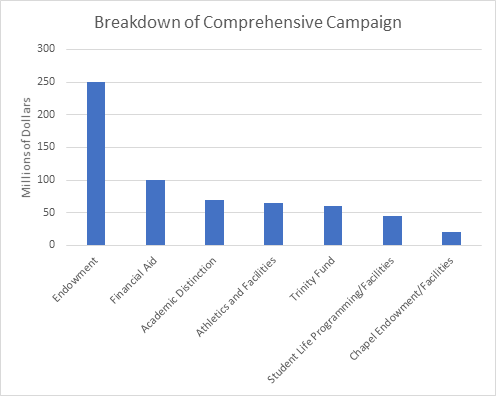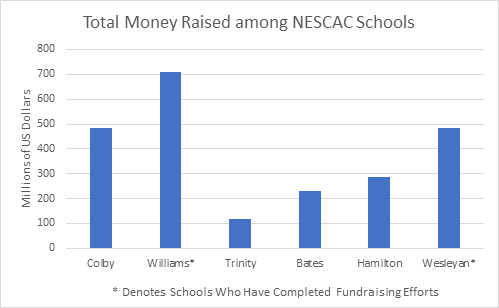Brendan Clark ’21
Managing Editor
Trinity College’s comprehensive campaign continues to progress in the “nucleus phase,” with approximately $118 million having been raised toward a total goal of $435 million. The campaign, which counts all monetary donations made between July 1, 2016 and June 30, 2023, includes donations to the Trinity College Fund, to the College’s endowment, to support annual athletics operations, to support the restoration of the Chapel, and to support the parent’s fund, among others. The total campaign objective of $435 million consists of $360 million in current gifts and $75 million in bequest intentions.
Comparative institutions which recently ran campaigns have set higher objectives than Trinity: Colby set a goal of $750 million for their “Dare Northward” campaign, which had raised $485 million by November 2019, while Williams set an objective of $650 million and ultimately raised $707.5 million by 2015. Colby had more than 32 contributors giving more than $1 million, while Williams achieved 74.3% alumni participation. Institutional comprehensive campaigns within our peer group have focused on highlighting major areas of need similar to Trinity’s: Colby’s “Dare Northward” campaign addressed financial aid, multidisciplinary programs under the aegis of “Colby Labs,” and revitalizing Colby’s athletic center. Williams campaign, “Teach It Forward,” also addressed alumni engagement and faculty recruitment, two categories distinct from Colby’s and Trinity’s campaign.

The last comprehensive campaign at Trinity, the “Cornerstone Campaign,” took place from 2006 to 2012 and raised $281.1 million toward a $300 million goal, while a concurrent Legacy Campaign raised $87.9 million toward a $75 million goal.
The Tripod spoke with Assistant Vice President for Advancement Christina Posniak and Associate Director of Gift Planning and 50th Reunion Caitlin Gasiorski to discuss the campaign’s progress and objectives. Posniak indicated that this campaign follows what is “an industry standard: you run a quiet phase until you have roughly 65% to 75% (between $282.75 to $326.25 million) in hand and then enter the public campaign.” Posniak added that keeping the public period of the campaign brief was important, as “if the campaign progresses publicly for too many years, you will lose momentum and energy.” According to Posniak, it is likely that the campaign will remain in this quiet phase for two to three more years. This is also within the industry standard: Posniak stated that most comprehensive campaigns last 6 to 8 years, while capital campaigns for particular projects continue for 2 to 3 years.
As to objectives, Posniak stated that we are “looking to increase our volunteer cohort by about 100 to 150 volunteers per year,” focusing especially on building interest in the College’s Long Walk Societies, which focus on giving in the range of $2,000 or above. The focus on the Long Walk Societies also includes outreach to current students and recent alumni, who “make the comprehensive campaign real,” added Posniak. Further, said Posniak, those who give significantly are generally “those who start giving very early.”

The campaign also includes as one focus endowing the Chapel and raising funds for its repair: that effort is being spearheaded by a “vibrant committee led by Bill Reynolds ’71,” together with support from the Class of 1963, which according to Posniak is looking to “restore and name the Friendship Chapel.” The campaign also seeks to address financial aid, with an objective of $100 million in that category. Gasiorski added that, among givers to the financial aid category, “there is a mix”; “those who really care about access to the institution and also many who were former recipients of financial aid themselves.” Posniak continued, noting that many donors in this category are very interested in “making a real difference for middle income students.”
Once the project enters the public phase, Posniak added that the “bicentennial events will dovetail nicely with the campaign objectives.” The promotion of the event publicly will include a campaign microsite, where community members can “track the progress of the campaign publicly” and utilize as a resource for “information on the progress of the campaign’s objectives.”
As the Tripod previously reported, $435 million in campaign funds will be ultimately allocated for different purposes on campus: $100 million will be directed toward “financial aid,” $70 million to “academic distinction,” $65 million to “endowing athletics and facilities,” $60 million to the “Trinity Fund,” $45 million to “student life programming and facilities,” and $20 million to the “Chapel endowment and facilities.” The Tripod also spoke with Chair of the Board of Trustees Cornelia P. Thornburgh ’80, who added that “as with any campaign, you don’t get all the money at once.” Thornburgh continued, adding that the campaign is a “critical one” for the College and that the “Board is excited to oversee it.” Trinity’s board had previously appointed two trustees, Kathryn G. Tyree ‘86 and Jeffery E. Kelter ‘76, P ‘18 as co-chairs in October of 2018.
Other NESCAC schools which ran recent campaigns include Bates, which set a goal of $300 million in 2017 (raising $229 million thus far), Hamilton, which set a goal of $400 million in 2018 (raising $235 million thus far), and Wesleyan, which set a goal of $400 million and ultimately raised $482 million by the end of 2016.





+ There are no comments
Add yours